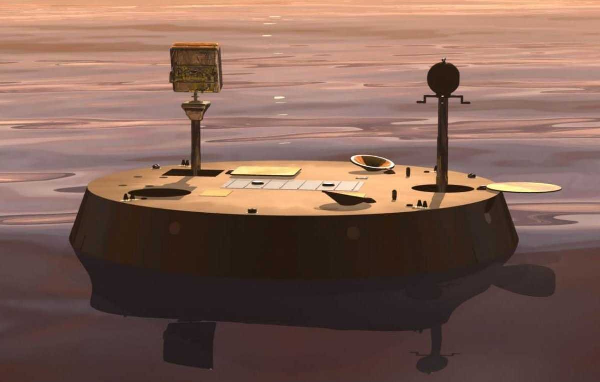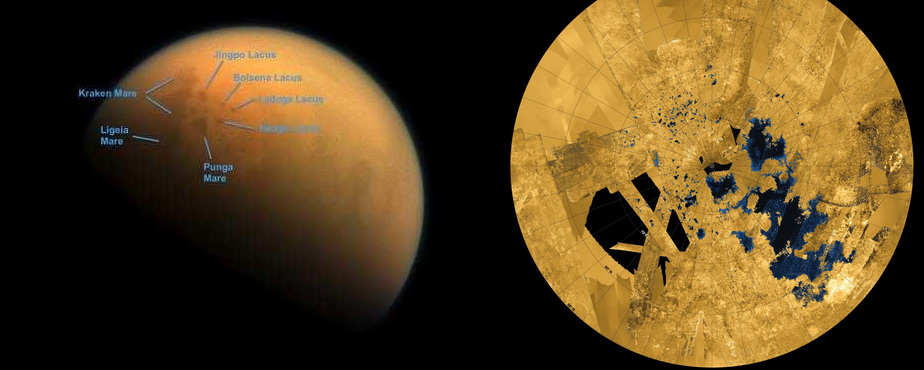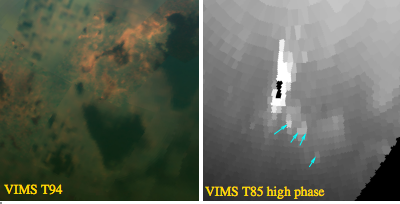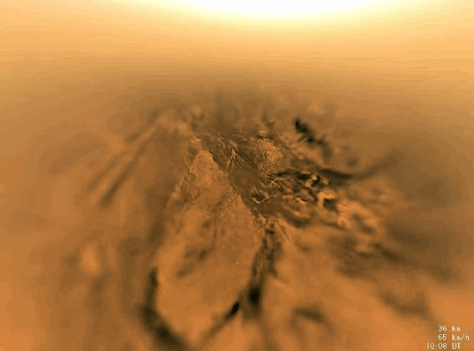TiME - space submarine
In 2009, the media wrote about the plans of NASA and ESA for the first space boat - a floating vessel, which would be engaged in exploring the lakes of one of Saturn's satellites. But in the context of priority, the project lost the mission to Jupiter. After some time, NASA again raised this topic in 2012. After reviewing 28 projects, three came out to the finals: a probe to Mars as part of the Insight mission, a Comet Hopper landing craft and a space boat called the Titan Marine Explorer (TiME). And again NASA made a choice not in favor of TiME, preferring the probe to Mars. NASA is currently in the process of collecting projects for the Discovery Program, and everyone is looking forward to see if TiME is there.

Titanium
In 2004, the Cassini spacecraft, using a radar and infrared telescope, was able to look under the deep orange clouds of Titan, Saturn’s largest satellite. Scientists were amazed that the landscape was very similar to the Earth, there were riverbeds, rains, clouds, lakes and the sea - for the first time something similar to our landscape was found outside the Earth. However, unlike Earth, the sea and the lake on Titan are mainly composed of methane and ethane. And yet the question remains, is it possible to swim there? Some think so. Large liquid bodies, like the sea of Pungi (the third largest liquid body on Titan ), are considered by scientists as an excellent platform for studying early life forms and an additional incentive for the approval of the TiME mission. In the pictures below, Titan and its north pole.

')
The best time to explore the seas of Titan, which are located near its north pole, is the first years of the 2020s - during the end of summer in the north of the satellite. At this time, the lakes are under daylight, and there will be the possibility of direct communication with the Earth without the use of special expensive equipment for signal transmission. But there is another problem - the shortage of plutonium. In space missions, radioisotope energy sources are used, which have no alternative for a mission to Titan. And this is a problem not only for TiME, but for all other missions. As of September 2013 , plutonium-238 stocks in the United States were 16 kilograms, and all of them are already scheduled for upcoming missions. Thus, if the TiME mission is not approved by NASA, the next launch can only be realized by the year 2040, when the end of summer at the North Pole will again be on Titan.
But TiME is not the only opportunity to research Titan, do not forget about the satellites. After years of study, scientists have discovered a wavy surface on one of the seas of Titan. “If this discovery is true, then these are the first waves discovered on the sea beyond the Earth’s borders,” scientists from the University of Idaho write in a press release published in March as part of the Lunar and Planetary Science conference. In the image below, the Punga Sea is in the shape of a heart in the left image, and the blue arrows in the right image indicate possible waves.

Judging from the photographs, scientists assume that the waves are 2 cm high and they are formed by wind at a speed of 2.73 km / h. Researchers can’t say for sure. there are doubts that it may not be waves, but silty rocks on the surface of the sea. More, the situation should clear up until 2017, when the winds, if they exist, will have to increase in the northern region of Titan, and then the waves will have to become even larger.
Additional materials on the topic:
1. Map of the North Pole of Titan
2. Sea Pungi

Titanium
In 2004, the Cassini spacecraft, using a radar and infrared telescope, was able to look under the deep orange clouds of Titan, Saturn’s largest satellite. Scientists were amazed that the landscape was very similar to the Earth, there were riverbeds, rains, clouds, lakes and the sea - for the first time something similar to our landscape was found outside the Earth. However, unlike Earth, the sea and the lake on Titan are mainly composed of methane and ethane. And yet the question remains, is it possible to swim there? Some think so. Large liquid bodies, like the sea of Pungi (the third largest liquid body on Titan ), are considered by scientists as an excellent platform for studying early life forms and an additional incentive for the approval of the TiME mission. In the pictures below, Titan and its north pole.

')
The best time to explore the seas of Titan, which are located near its north pole, is the first years of the 2020s - during the end of summer in the north of the satellite. At this time, the lakes are under daylight, and there will be the possibility of direct communication with the Earth without the use of special expensive equipment for signal transmission. But there is another problem - the shortage of plutonium. In space missions, radioisotope energy sources are used, which have no alternative for a mission to Titan. And this is a problem not only for TiME, but for all other missions. As of September 2013 , plutonium-238 stocks in the United States were 16 kilograms, and all of them are already scheduled for upcoming missions. Thus, if the TiME mission is not approved by NASA, the next launch can only be realized by the year 2040, when the end of summer at the North Pole will again be on Titan.
But TiME is not the only opportunity to research Titan, do not forget about the satellites. After years of study, scientists have discovered a wavy surface on one of the seas of Titan. “If this discovery is true, then these are the first waves discovered on the sea beyond the Earth’s borders,” scientists from the University of Idaho write in a press release published in March as part of the Lunar and Planetary Science conference. In the image below, the Punga Sea is in the shape of a heart in the left image, and the blue arrows in the right image indicate possible waves.

Judging from the photographs, scientists assume that the waves are 2 cm high and they are formed by wind at a speed of 2.73 km / h. Researchers can’t say for sure. there are doubts that it may not be waves, but silty rocks on the surface of the sea. More, the situation should clear up until 2017, when the winds, if they exist, will have to increase in the northern region of Titan, and then the waves will have to become even larger.
Frames made in 2007, when Cassini dropped the Huygens probe onto a satellite (13Mb)

Additional materials on the topic:
1. Map of the North Pole of Titan
2. Sea Pungi
Source: https://habr.com/ru/post/226049/
All Articles